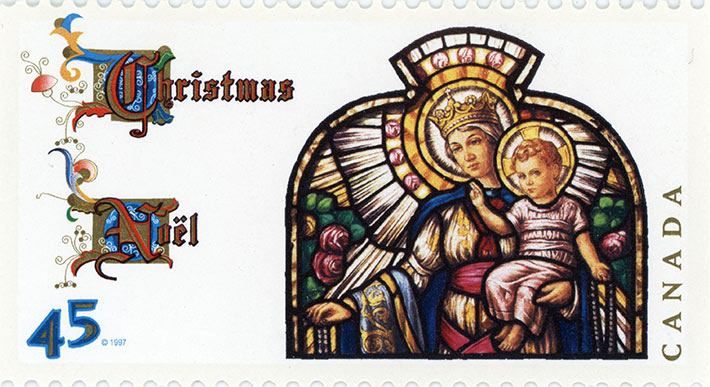Christmas stamp, Our Lady of the Rosary, stained glass by Guido Nincheri, 1997
45-cent Christmas stamp of the Our Lady of the Rosary stained glass in Holy Rosary Cathedral in Vancouver, B.C., by Guido Nincheri. Nincheri's Our Lady of the Holy Rosary is among three Christmas stamps issued in 1997 by Canada Post featuring the madonna and child theme in a stained-glass window design. The 52-cent stamp is based on the "Nativity Scene" designed by Ellen Simon and Yvonne Williams, and the 90-cent stamp comes from the "Scene from the Life of the Blessed Virgin" designed by Christopher Wallis.
Guido Nincheri has been described as one of the most important religious artists in Canadian history. He certainly was prolific, producing a range of work in many mediums, including about five thousand stained glass windows throughout Canada as well as in the United States.
"Nincheri’s stained glass style is unmistakable. His technique is in the mode of Italian Renaissance painting: dramatic and dynamic but resolutely realistic, at least by 20th century standards. The three-dimensional modeling of his figures is uncommon in stained glass, but Nincheri had the luxury of live models, including his wife Giulia, and sometimes his studio colleagues. His broad colour palette can seem overwhelming until you find the subtleties. A characteristic technique is the depiction of boldly rendered rays, emitting symmetrically from sacred figures like Jesus, Mary and the Angels. His border ornamentation is fresh and harmonious." (Institue for Stained Glass in Canada; http://www.stainedglasscanada.ca/articles/nincheri.htm)
This stamp depicts a section of Nincheri's Our Lady of the Holy Rosary. The madonna and child hold a rosary in their hands. Also depicted in the stained glass window, but not seen in the stamp, are St. Dominic and St. Catherine of Siena. In 1941, Nincheri was hired to create stained glass windows for the church in Vancouver. This window was among five installed in 1941. At the time of this work, Nincheri would have just experienced a very dark period in his life and career, having been interned for the latter part of 1940 at Camp Petawawa.











